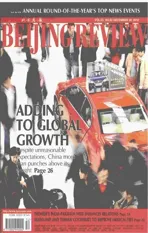Global Recovery: East and West
2010-12-27本刊编辑部
Global Recovery: East and West
Although the global financial crisis broke out more than two years ago, the fate of the world economy remains uncertain.The recently released Standard Chartered Global Focus:2011—The Year Ahead showed that there is no unified subject regarding recovery—at least two worlds exist—but that recovery is likely on the way. Edited excerpts follow:
The past year, 2010, was a year of recovery, albeit an uneven one. It was a tale of two worlds: a buoyant East contrasting w ith a sluggish West.
The size of global GDP is already back to pre-recession levels and is likely to grow further. A fter grow th of 3.7 percent this year, we should see the world economy grow ing 2.9 percent in 2011 and then 3.4 percent in 2012.
Domestic demand is the key economic variable to focus on in 2011. The fundamentals driving domestic demand vary considerab ly across the globe.Take Asia, for instance, where the employment outlook appears solid, wages are rising and asset prices appear to be on an upward trend. All of this should be positive for consumption. Against this are measures to curb rising asset prices and the negative impact of rising food and commodity prices, which hit those w ith lower incomes the hardest.So while there are some offsetting factors, the combination of jobs, w ages and asset prices is generally positive for spending across Asia. The opposite is true for the United States and other Western countries.
Next year, 2011, should see a further divergence in global econom ic policy,reflecting differing fundamentals around the world.
While we expect inflation to trigger rising rates across the emerging world,monetary policy in the West looks set to remain accommodative. It’s unlikely the U.S. Federal Reserve w ill take tightening action in 2011 or even in 2012. More quantitative easing could occur. The European Central Bank, meanwhile, may drain liquidity and come under pressure from Germany to tighten.
Extreme events, which are unlikely to occur, but still possible and should not be ruled out, include: Another financial crisis triggered by a weak econom ic outlook that makes it hard to roll over maturing bank borrowing or government debt; inflation bubbles across Asia if policymakers fail to act on already evident pressures; a deflation environment that triggers a collapse of the euro, w ith some countries leaving the euro zone; or political problems as divergent economic outlooks force Western policymakers to adopt protectionist measures.
However improbable these extremes may be, the fact they could occur adds both uncertainty and volatility to financial markets, and could possibly create uncertainty for policy decisions over the course of the year.
The near-term challenges for the world economy should not be underestimated. The fear of demand deficiency in the West is genuine as the policy stimulus wears off and as the overhang of debt points to further restraint.
Despite that, there are also huge upside pressures, and we believe the world economy is on an upward path—but not always an unwavering one. Emerging econom ies account for one third of the world economy, but account for two thirds of its grow th. This shift in the balance of econom ic and financial power looks set to continue, driven by better fundamentals, policy actions and increasing confidence.
